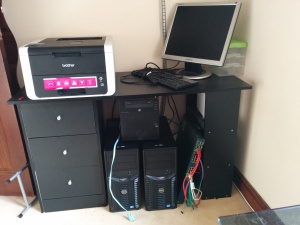Any of you who have seen me at the VMUG events will know I stress the importance of a home lab when studying or even just practising big changes before you attempt them on a customers test site.
Home Lab sprawl.
Having recently moved house, I have been forced to admit the cupboard under the stairs where I used to house my lab was a bit bigger than I thought. In my new home office, I have to live with the kit behind me and that has made me reconsider what options I and you have to ensure we can stay up to date.
The two common issues that come up when dealing with home study are cost and space. So I have taken the time to write down a number of options that allow you to either condense your home lab or if you are feeling brave, do away with it completely.
Hands on Labs http://labs.hol.vmware.com/HOL/catalogs/
This one can not be stressed enough, they are phenomenal. They are always available, have some great deployment examples, and the instructions contain some great nuggets. In fact, a few of the View tools I now use quite often, I learned directly from one of these labs. I have had the pleasure of the Lab tour and knowing one of the Lab creators (for VMWorld) and VMware really have put some serious investment in to ensuring we can try their technology.
VMware Workstation / Fusion http://store.vmware.com/store/vmwde/en_GB/home
My home lab is quite powerful, and I even offer it out sometimes (remotely) to people who just want to practice a particular thing. However, it never ceases to impress me when my colleague turns up with his demo lab on his Mac. If space and price are the pinch points, this is certainly a way forward. ESX can be virtualized, and while some of the advanced features can’t be tested it does give you a very portable lab that can help you study anywhere.
PluralSight http://www.pluralsight.com/
While not a home lab, I find it invaluable if I just want a refresher of the interfaces. I can watch the demonstrations and as they always use a lab example it’s easy to see how the set up would look. For general education, they are very much worth their money, and I find I download a few to watch on train journeys.
GNS3 http://www.gns3.com/
I make no secret that I find networking the least interesting part of my role. However GNS3 does allow you to create fully fledged networks using the Cisco images. It’s great to spin it up and ensure your network design truly makes sense before you put pen to paper.
VMUG Events / Conferences http://www.vmug.com
Don’t underestimate your local VMUG, They will be more than happy to do a lab session or ask a vendor to provide demo kit if it’s something the user group would find interesting. As one of the VMUG leaders for the UK North West VMUG, one thing I try to do is deliver what our members want, whether that be presentations, HOL, or Demos.
Educational Centre http://www.educationalcentre.co.uk/type/cisco/
A good friend of mine recently completed his CCNP and has written some great notes on Cisco Networking generally. He does his best to get me interested in networking and in general it does work as he speaks quite passionately about it. These blogs are not overbearing and he does a great job of taking you through the 5 day course he attended, I find them informative without dragging me into the “oh no its networking” zone. If they are any use, ping him a tweet @saintdle.
Any others?
As you can imagine I expect this to be an envolving article as more technologies and options for home labs comes to my attention. I realise I have missed off many of the staples (ie freenas etc) but the main point of the article was to show what tools can be used to either compliment or replace your existing lab.
As for my lab, its noisy and it’s huge but it will stay, if for no other reason than sometimes when I am troubleshooting or learning, I like to be able to see the actual kit I am fighting with. The above will compliment the lab, and probably replace some of the tasks I used to use it for, but for now, the cheap black desk and whirring of fans will remain.

Leave a Reply